

Stanford Archives sur Twitter : "Varian, Inc. photos documenting early history of #SiliconValley: @StanfordEng @Liebenwalde. Varian, Inc. Records (SC0889) - an album on Flickr. USA TODAY: Latest World and US News - USATODAY.com. Stanford archives open window into Apple origins. Palo Alto -- In the interview, Steve Wozniak and the late Steve Jobs recall a seminal moment in Silicon Valley history - how they named their upstart computer company 35 years ago.
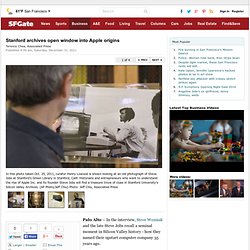
"I remember driving down Highway 85," Wozniak says. "We're on the freeway, and Steve mentions, 'I've got a name: Apple Computer.' We kept thinking of other alternatives to that name, and we couldn't think of anything better. " Adds Jobs: "And also remember that I worked at Atari, and it got us ahead of Atari in the phone book. " The interview, recorded for an in-house video for company employees in the mid-1980s, was among a storehouse of materials Apple had been collecting for a company museum.
Within a few days, Stanford curators were at Apple headquarters in nearby Cupertino, packing two moving trucks full of documents, books, software, videotapes and marketing materials that now make up the core of Stanford's Apple Collection. Historical materials. Archives offer window into Apple's origins – USATODAY.com. PALO ALTO, Calif. – In the interview, Steve Wozniak and the late Steve Jobs recall a seminal moment in Silicon Valley history — how they named their upstart computer company some 35 years ago.
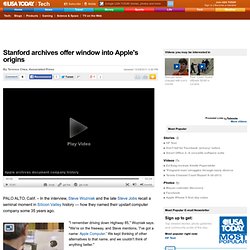
"I remember driving down Highway 85," Wozniak says. Apple's Museum That Never Was: Why Does Stanford Keep it Secret? Where does the world's largest collection of Apple-related history live? In a fascinating archive owned and operated by Stanford University. But good luck actually finding the trove of hardware, software, recorded interviews, revealing documents, candid photos and internal videos. Everything is stored in a secret Bay Area location away from the Stanford campus. Unceremoniously housed in boxes that occupy some 600 feet of shelving in a climate-controlled warehouse, the archive contains gems such as handwritten early sales records of the Apple II, a $5,000 loan agreement that helped the fledgling company get off the ground, and a 1976 letter in which a printer warns a friend about a young "joker" named Steve Jobs.
Mashable has reached out to Stanford for more information on why this bonanza of Apple-geek gold hasn't been made more available for viewing by the general public, but so far has not heard back from university representatives. John Sculley Just Gave His Most Detailed Account Ever Of How Steve Jobs Got Fired From Apple. Apple Computer collections. Mikel Rouse Web Site. The Demo is a music theater work written by composer/performers Mikel Rouse and Ben Neill based on Douglas Engelbart’s historic 1968 demonstration of early computer technology.
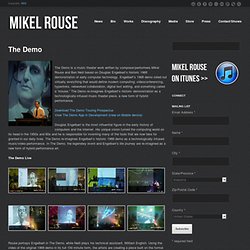
Engelbart’s 1968 demo rolled out virtually everything that would define modern computing; videoconferencing, hyperlinks, networked collaboration, digital text editing, and something called a “mouse.” The Demo re-imagines Engelbart’s historic demonstration as a technologically-infused music theater piece, a new form of hybrid performance. Download The Demo Touring ProspectusView The Demo App in Development (view on Mobile device) Douglas Engelbart is the most influential figure in the early history of computers and the Internet. His unique vision turned the computing world on its head in the 1950s and 60s and he is responsible for inventing many of the tools that we now take for granted in our daily lives. The Demo Live The Demo Visualization Sessions at NCSA Photos by: Valerie Oliveiro, NCSA and Gibson Nolte. Steve Jobs Explains How Every Tech Innovation Will Be Lost to History. Alcorn, Al (Allan) oral history. Catalog Number Title Alcorn, Al (Allan) oral history Type Text Date Contributor Publisher.
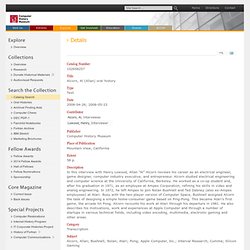
Ampex training film SP300 : Ampex Corporation. <div style="padding:5px; font-size:80%; width:300px; background-color:white; margin-left:auto; margin-right:auto; border:1px dashed gray;"> Internet Archive's<!
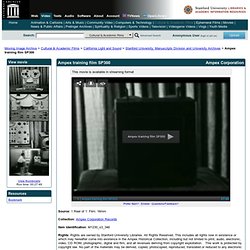
--'--> in-browser video player requires JavaScript to be enabled. It appears your browser does not have it turned on. Please see your browser settings for this feature. The Sad Tale of a Forgotten Apple Co-Founder and His Lost Billions (AAPL) Steve Jobs, Steve Wozniak, and Ronald Wayne came together in a suburban bedroom in Los Altos, Calif., to found Apple Computer (NASDAQ: AAPL ) on April 1, 1976.
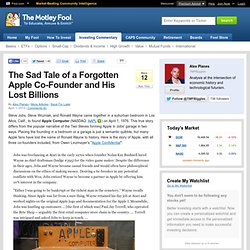
This true story differs from the popular narrative of the Two Steves forming Apple in Jobs' garage in two ways. Placing the founding in a bedroom or a garage is just a semantic quibble, but many Apple fans have lost the name of Ronald Wayne to history. Here is the story of Apple, with all three co-founders included, from Owen Linzmayer's "Apple Confidential": Jobs was freelancing at Atari in the early 1970s when founder Nolan Kay Bushnell hired Wayne as chief draftsman (badge #395) for the video game maker.
Despite the difference in their ages, Jobs and Wayne became casual friends and would often have philosophical discussions on the ethics of making money. The young, ambitious Jobs had no qualms about going into debt to fulfill the Byte Shop order, but the seasoned Wayne was anxious. Don't lament the big gainers that got away.